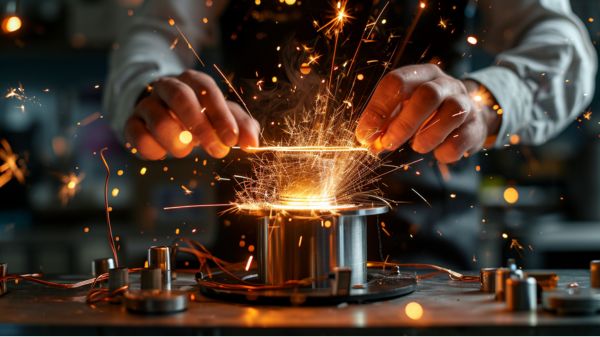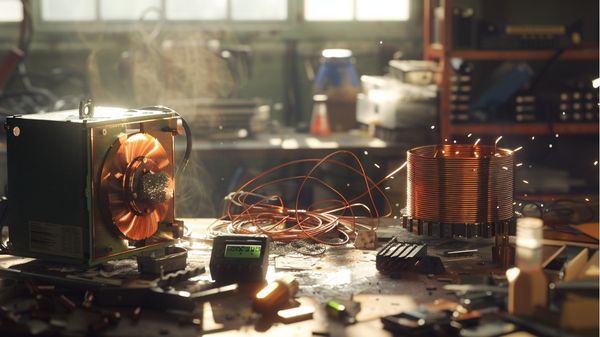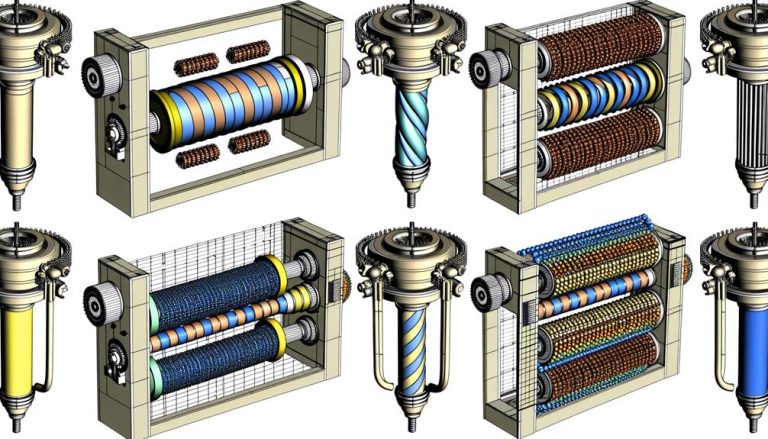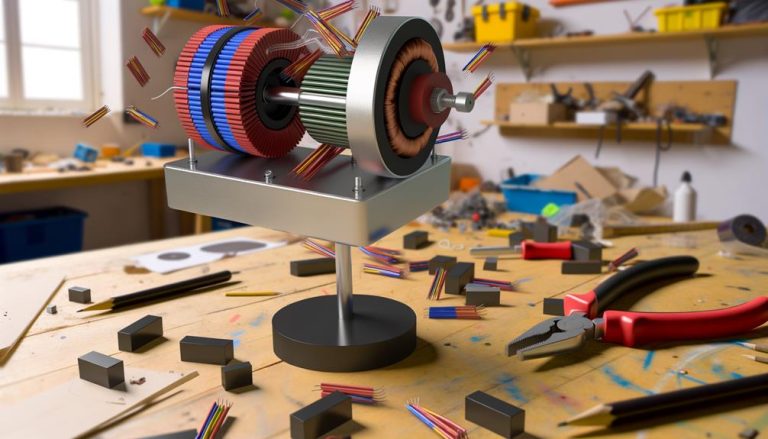You might be thinking, ‘Why should I bother with DIY Faraday Induction Electricity Projects?’ Well, let me assure you that these projects are not only educational but also incredibly fascinating. Imagine being able to generate electric current simply by using a coil and a magnet. It’s like having a mini science experiment right in your own home.
And the best part? These projects are easy to do and require materials that you probably already have lying around. So, if you’re curious about the wonders of electromagnetic induction and want to explore the world of electricity, then keep reading to discover these 8 DIY projects that will leave you amazed.
⚡OFF-GRID POWER⚡
Build a Home Power Backup—No Utility Needed
Looking to keep essentials running during outages? The Ultimate Off-Grid Generator course walks you through a DIY backup system with simple parts and step-by-step plans — ideal for homesteads, cabins, or emergency prep.
Key Takeaways
- Electromagnetic induction is the foundation for various DIY projects such as copper coil experiments, electric generators, magnetic induction flashlights, and Faraday’s magnetic pendulum.
- It is an important concept that enables the functionality of electric generators, transformers, electric bicycle charging stations, and DIY magnetic induction motors.
- Electric bicycle charging stations utilize wireless charging technology, renewable energy sources, and the induction of electric current through coils and magnets.
- DIY magnetic induction motors require proper construction techniques, coil winding techniques, optimization of the magnetic field, and balancing of motor components for smooth operation.
Simple Copper Coil Experiment
In this simple copper coil experiment, you’ll use coils of different loop numbers and a bar magnet to demonstrate electromagnetic induction. This experiment is a great way to understand how current can be generated using copper wire winding.
By moving the magnet in and out of the coil, you’re able to induce a current in the wire. The ammeter needle will show a greater deflection when there are more loops in the coil. This is because the current induced is proportional to the number of turns in the coil.
It’s important to note that the rate of change of the magnetic field also affects the induced current. By increasing the speed at which you move the magnet, you can observe a larger current generation.
This experiment is a simple yet effective way to demonstrate the principles of electromagnetic induction and the relationship between copper wire winding, the number of loops, and current generation. It provides a hands-on experience that allows you to understand the concepts in a tangible way.
Homemade Electric Generator
Create your own electric generator using a coil of wire and a magnet. This DIY generator is a great way to demonstrate electromagnetic induction. By moving the magnet in and out of the coil, you can induce a current in the wire. The number of loops in the coil will affect the amount of current generated. More loops will result in a greater current.
To measure the efficiency of your DIY generator, you can monitor the resistance of the whole circuit. The current induced is inversely proportional to the resistance, so a lower resistance will result in a higher current.
This homemade electric generator is a practical and educational way to understand Faraday’s law. According to this law, the induced electromotive force (EMF) is equal to the negative rate of change of magnetic flux. By experimenting with your DIY generator, you can explore the fundamental principles of electricity and magnetism.
Liberating yourself from the constraints of traditional power sources, you can harness the power of electromagnetic induction with your very own homemade electric generator.
⚡OFF-GRID POWER⚡
Build a Home Power Backup—No Utility Needed
Looking to keep essentials running during outages? The Ultimate Off-Grid Generator course walks you through a DIY backup system with simple parts and step-by-step plans — ideal for homesteads, cabins, or emergency prep.
Magnetic Induction Flashlight
To construct a magnetic induction flashlight, you’ll need a coil and a magnet that you can move in and out of the coil. This flashlight operates on the principle of electromagnetic induction, which was discovered by Michael Faraday in the early 19th century.
When you move the magnet in and out of the coil, it creates a changing magnetic field. This changing magnetic field induces a current in the coil, according to Faraday’s law of electromagnetic induction. The induced current powers the LED in the flashlight, allowing it to produce light without the need for traditional batteries.
The magnetic induction flashlight is a practical application of Faraday’s discovery. It demonstrates how you can use electromagnetic induction to generate electricity and power devices. It’s a great DIY project for understanding and experimenting with electromagnetic induction. By building your own magnetic induction flashlight, you can learn about the relationship between magnetism and electricity and explore the principles of electromagnetism.
In addition to the magnetic induction flashlight, you can also experiment with other electromagnetic induction projects, such as a magnetic induction charger. These projects allow you to harness the power of electromagnetic induction and explore its applications in everyday life. So, grab your coil and magnet, and start exploring the world of electromagnetic induction through these exciting experiments.
DIY Induction Heating System
Now let’s delve into the key points of induction coil design and temperature control methods in DIY induction heating systems.
The design of the induction coil is crucial as it determines the efficiency and effectiveness of the heating process. Consider factors such as the number of turns, coil shape, and dimensions.
Additionally, temperature control methods play a vital role in ensuring precise heating, and you can utilize options like PID controllers or thermocouples for accurate temperature management.
Induction Coil Design
For optimal performance in your DIY induction heating system, carefully design the induction coil. Consider the following factors to ensure efficient and effective coil design:
- Coil Winding Techniques: Utilize proper winding techniques to achieve a tightly wound coil with minimal gaps and overlaps. This will enhance the magnetic field strength and improve energy transfer.
- Coil Material: Select a material with high electrical conductivity, such as copper or aluminum, to minimize resistive losses and maximize power output.
- Coil Shape: Experiment with different coil shapes, such as solenoid or pancake, to optimize the coupling between the coil and the workpiece for maximum heating efficiency.
- Coil Size: Determine the appropriate size of the coil based on the desired heating area and the power requirements of your system.
- Coil Cooling: Incorporate cooling mechanisms, such as water cooling or forced air cooling, to prevent overheating and ensure prolonged coil lifespan.
Temperature Control Methods
One effective method for controlling the temperature in a DIY induction heating system is by implementing a feedback loop that adjusts the power input based on temperature readings. A common temperature control method is to use a thermocouple to monitor the workpiece temperature and regulate the power input accordingly.
Another approach is to utilize a closed-loop control system with a PID controller, which allows for precise regulation of the power input to maintain a consistent temperature. You can also use pyrometers or infrared thermometers to measure the workpiece temperature and provide feedback for controlling the induction heating system.
When comparing temperature measurement options, thermocouples are often preferred due to their durability and accuracy, while pyrometers offer the advantage of non-contact temperature measurement.
Additionally, some DIY setups incorporate a water cooling system to manage the temperature of the inductor coil and prevent overheating during induction heating processes.
Faraday’s Magnetic Pendulum
Faraday’s Magnetic Pendulum demonstrates the principles of electromagnetic induction through the motion of a magnet within a coil of wire. This experiment, based on Faraday and Henry’s discovery of electromagnetic induction in 1831, showcases the generation of an electric current in a conductor by changing the magnetic field around it.
Here are five key facts about Faraday’s Magnetic Pendulum:
- Demonstrates electromagnetic induction: The pendulum’s magnet moves back and forth within a coil of wire, creating a changing magnetic field that induces an electric current in the wire.
- Shows the effects of magnetic field changes: As the magnet swings, the induced current causes the pendulum to oscillate, showcasing the relationship between magnetic field changes and current generation.
- Illustrates the role of rate of change: The speed and direction of the magnet’s movement affect the rate of change of the magnetic field, which in turn influences the magnitude of the induced current.
- Foundation for electric generators: Faraday’s experiment laid the groundwork for the development of electric generators that produce electricity through electromagnetic induction.
- Enables transformer functionality: Understanding electromagnetic induction is crucial for the operation of transformers, which rely on changing magnetic fields to transfer electrical energy.
Faraday’s Magnetic Pendulum offers a hands-on experience to comprehend the principles of electromagnetic induction and its applications in various electrical devices. By engaging in pendulum induction experiments, you can gain a deeper understanding of the fundamental concepts behind the generation and transformation of electricity.
Related Post: 10 Magnet-Powered Generators for Alternative Energy.
Electric Bicycle Charging Station
To understand the functioning of an electric bicycle charging station, one must comprehend the principles of electromagnetic induction. This innovative technology utilizes the concept of wireless charging and renewable energy sources to provide a sustainable solution for powering electric bicycles.
The charging station consists of coils of wire and magnets that work together to induce electric current in the bicycle’s battery. When an electric bicycle is placed near the charging station, the magnetic field generated by the magnets passes through the coils of wire, creating a changing magnetic flux. This changing magnetic flux induces an electric current in the wire, which is then transferred to the battery, charging it.
The number of coil loops in the charging station affects the amount of current induced. You can improve the charging efficiency by increasing the number of coil loops, allowing for faster and more effective charging of the electric bicycle.
This electric bicycle charging station demonstrates the practical application of electromagnetic induction for sustainable transportation. By harnessing renewable energy sources such as wind or solar power, the charging station can operate without relying on fossil fuels, making it an environmentally friendly option.
DIY Magnetic Induction Motor
Now let’s talk about the construction techniques involved in building a DIY magnetic induction motor.
By understanding how to properly assemble the coil of wire, position the magnet, and connect the power source, you can create a functional motor.
Additionally, exploring the various applications of induction motors will give you a deeper insight into their practical uses in everyday devices and machinery.
Motor Construction Techniques
When constructing a DIY magnetic induction motor, careful placement of the coil and magnets is essential to ensure proper interaction and generate motion. Here are five motor construction techniques to consider:
- Motor winding techniques: The coil’s wire gauge and number of turns greatly affect the motor’s performance and efficiency. Experiment with different winding techniques to optimize the motor’s electromagnetic capabilities.
- Magnetic field optimization: Proper alignment and positioning of the permanent magnets is crucial for maximizing the motor’s magnetic field strength. Securely attach the magnets and distribute them evenly around the coil.
- Balancing the motor components: Achieving balance in the physical construction of the motor is vital for smooth operation. Make sure to properly align the armature, coil, and magnets and center to prevent any unwanted vibrations or imbalances.
- Understanding electromagnetic induction principles: Familiarize yourself with the fundamentals of electromagnetic induction to comprehend how the motor generates motion. This knowledge will help you troubleshoot and fine-tune your DIY motor.
- Experimentation and adjustment: Building a DIY magnetic induction motor is a process of trial and error. Get ready to experiment with different techniques, adjust the positioning of the coil and magnets, and make iterative improvements to optimize your motor’s performance.
Induction Motor Applications
Induction motor applications expand through the construction of DIY magnetic induction motors using simple materials and a power source. These motors have a wide range of advantages, including high efficiency, reliability, and low maintenance requirements. However, they also come with a few disadvantages, such as the need for a separate power factor correction device and the potential for reduced efficiency at low speeds.
To help you understand the benefits and drawbacks of DIY induction motors, here is a table summarizing the key points:
| Advantages | Disadvantages | Efficiency |
|---|---|---|
| High efficiency | Need for power factor correction | Varies with speed |
| Reliable | Reduced efficiency at low speeds | |
| Low maintenance |
Portable Induction Cooker
A portable induction cooker is a compact and efficient device that uses electromagnetic induction to directly heat cookware, providing precise temperature control and energy efficiency. Here are some important facts about portable induction cookers:
- Compact and Portable: These cookers are small and lightweight, allowing you to easily move them around and cook in different locations. This flexibility is especially useful for those with limited kitchen space or for outdoor cooking.
- Energy Efficient: Induction cookers are highly efficient because they only generate heat in the cookware itself, rather than heating up the surrounding air. This means less wasted energy and lower electricity bills.
- Precise Temperature Control: Unlike traditional gas or electric cooktops, induction cookers offer precise temperature control. You can easily adjust the heat levels to suit different cooking techniques, from gentle simmering to rapid boiling.
- Safety Features: Induction cookers are safe to use because the cooktop stays cool to the touch, reducing the risk of burns. This makes them particularly suitable for households with children or anyone concerned about kitchen safety.
- Easy to Clean: The smooth and flat surface of induction cookers makes them easy to clean. Since the cooktop doesn’t get hot, spills and splatters are less likely to burn onto the surface, simplifying the cleaning process.
Conclusion
These 8 DIY Faraday induction electricity projects provide a hands-on way to understand the principles of electromagnetic induction.
By experimenting with coils of different loop numbers and a bar magnet, one can generate electric currents and explore the relationship between current and resistance.
One interesting statistic is that Faraday’s law states that the electromotive force induced in a circuit is equal to the negative rate of change of magnetic flux.
These projects offer a practical and informative way to learn about the significance of electromagnetic induction in the development of electric generators and transformers.
⚡OFF-GRID POWER⚡
Build a Home Power Backup—No Utility Needed
Looking to keep essentials running during outages? The Ultimate Off-Grid Generator course walks you through a DIY backup system with simple parts and step-by-step plans — ideal for homesteads, cabins, or emergency prep.




